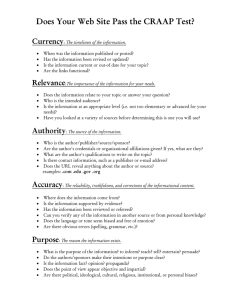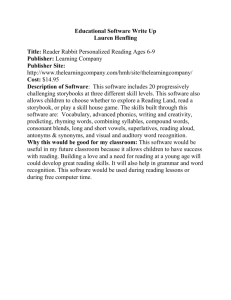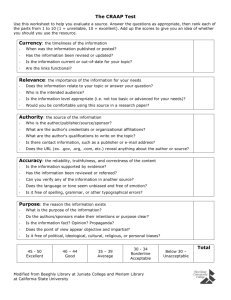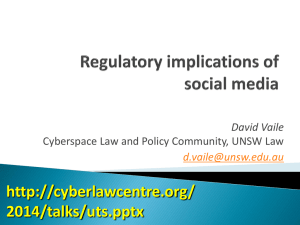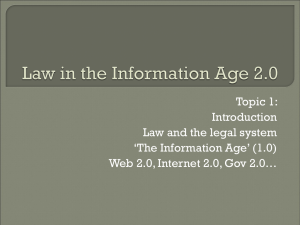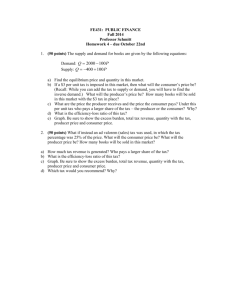Software and Ethics - Cyberspace Law and Policy Centre
advertisement
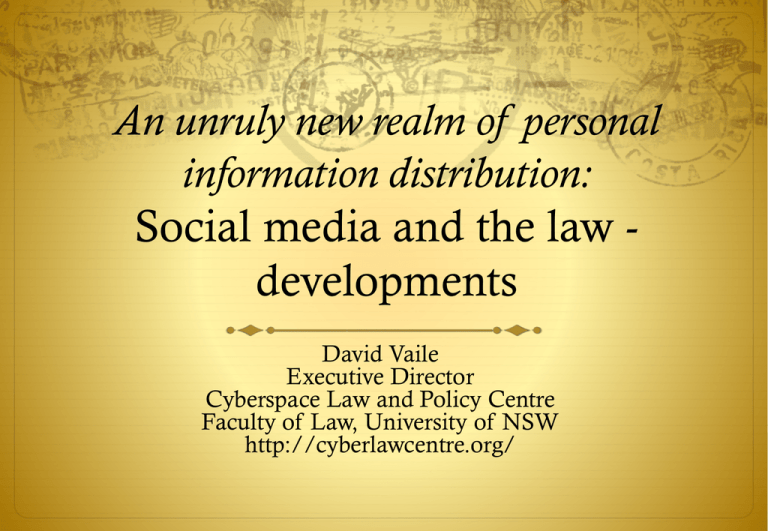
An unruly new realm of personal information distribution: Social media and the law developments David Vaile Executive Director Cyberspace Law and Policy Centre Faculty of Law, University of NSW http://cyberlawcentre.org/ Outline Regulation Lessig and Code Infinitely Long and Short Online and Social media impacts Australian v International material Technological changes IT security: Perimeter must fail Legal disconnects Four horsemen of the personal info sedurity apocalypse Struggle for regulators to keep up Challenges for regulation Recent Prosecutions Where are we left? Special Features of the online social environment A ‘wicked problem’? Lawrence Lessig’s Code Lessig identifies possible sources of regulation (Code and other laws of cyberspace – 2.0) http://codev2.cc/ Law (black letter, cf. actually enforced? Privacy?) Technology itself, a.k.a. 'Code’ (functions/limits) Social norms (netiquette, social practices?) Business practice (new social host busines models, where the user is product, not customer?) Online and social media impacts Tech changes Cultural changes Legal changes Technological changes underlying Offline world was nice and simple, for regulators and courts Web 1.0: global publication, old media publish models: AustLII Web 2.0: social networking, user generated content: Facebook 1 Convergence of producer and consumer, + distributor Web 3.0?: mass personalisation, semantic web, wearable tech. It’s not just your friends who know you and what you mean Attack of the killer toddlers – we are so old! Hackers retire at 15, kids turning tech. tables on parents, ‘slash’ Facebook does not enforce own entry test of ‘at least 13 yrs old’ Ye Olde Worlde (–2006) Reader Producer Importer Block here? Publisher Block here? Viewer Listener New fangled (SNS/UGC) Producer Publisher Reader Producer Publisher Reader Producer Publisher Reader Producer Publisher Reader Producer Publisher Reader ISPs: the new block point And then there was ‘2.0’: Features Social networking, user generated content, degenerate narcissism Blurs boundary: Publishing cf. Personal Communications From centralised one-to-many topology to distributed network Everyone is both consumer and producer (‘prosumer’) Everyone is a permanent global publisher; can be intermediary Every device is an endless movie source: deluge of data No editorial brain involved (both users and ISPs)? No selection? ISP replaces Publisher as key point – very significant? iiNet Legal disconnects: ‘Info just wants to be free’? Cyberlibertarian fantasies still delude and excite (Decl. of Indep. ‘96) Reality: Jurisdiction out of control, hyper liability (for you) Intensification, not escape, from jurisdiction (revenge of the States) Or: no care, and no responsibility? (for the Cloud) Your data and business go offshore, but not legal protection? The rise of the sub-human: minors at the frontier Deficit in ‘consequences’ cognitive development: paternalism? ‘Under the age of 18 or appears to be under 18’: kids make porn? The fall of the ‘common carrier’: ISPs reluctantly change masters? Agents of a foreign power, or a hostile litigant interest? CoE CC Enforced discipline of their customers, on pain of sharing liability? The struggle for regulators to keep up Offline: centralised distribution, choke points: edit/publish Web 1.0: more distributors, easier importation Web 2.0: everyone is a creator, (re)-publisher, exporter Web 3.0: the Cloud knows what you like, and makes it? Encryption and roll-your-own protocols already in use The long cyber-war: endless arms race between the straiteners and those seeking to avoid the blocks? Enlivened by real armies. When is publication not publication? Confused discussion: Surely it is censorship? No First Amdt. Chinese solution: you never know: the Panopticon: (no-one home, but you self censor) Special Features of the Online Social Environment Lifespan Cultural changes Legal changes Why online media control might be a ‘wicked problem’ Rapid constant evolution of technology, cultures and practices Scope is unmanageable? A billion FB users, a trillion items Classification model unviable? Urge to ‘filter’ - terminology Design philosophy of the net – under attack? Or net resists all? Supposed beneficiaries of protection also main perpetrators? Moral panic: ‘The Panic Button’ as solution? Overcriminalised? Real targets are parents? Wishful thinking? Or real victims? Temptations of ‘policy-based evidence’? Filter, safety, retention... Infinitely long and short lifespans ‘The Document that Never Dies’ ‘Document that Hardly Ever Lived’ Google Cache: days [next] Instant messaging, text: Internet Archive/ Wayback Machine: years http://archive.org/ [next] Arab Spring 2.0 demonstrates they are not really transient, but used as if... ? Snapchat: www.snapchat.com A smartphone app shares photos and videos that self-destruct after viewed once for up to 10 seconds; warns if recipients attempt to capture screen? [Next] Pandora (NLA) http://pandora.nla.gov.au/ Tor: encrypted onion router/VPN Legitimate personal copies Fast Flux injection: malware staple Illicit personal copies Roll your own protocols and tools! Facebook’s ‘inactive’ accounts: creature from the black lagoon? DFAT, former ASIO, chief declines to commit to writing (Zygier case) Cache Wayback SnapChat Australian cf. international material Extraterritoriality, foreign jurisdiction limits, ‘data sovereignty’ Difficulties for censorship, suppression, takedown, prosecution Onshore: Notices (Content Takedown, Link deletion, Stream cessation) for items hosted in Australia from ACMA, Courts Directed not at author or owner, but ICH, intermediary No motive to resist? Or seek actual classification, review? No obligation online to classify, check, edit (cf film, game, publ.) ‘Prohibited’ or ‘Potentially prohibited’: RC, X18+, some R18+, MA15+ Offshore: ACMA blacklist based on complaint, Interpol C.P. blacklist in ‘voluntary’ ISP ‘filters’. Otherwise? Most untouched. Potential to use Council of Europe Cybercrime Convention by, and in, USA and EU to streamline criminal prosecution: 1/3/13! Perimeter security: FAIL Firewall Antivirus Other IT security Anti spyware Common sense Why IT perimeter security must fail Needs to be 100% effective For a connected device, 99.9% means that 0.1% loophole will be found, in seconds or weeks. No IT security tools is even 99.9% effective. The other side are in a constant arms race with the IT security providers and other vendors trying to keep them out. They only need the tiniest crack – easy to achieve eventually Constant innovation by some of the smartest IT people on the planet, and legions of ‘script kiddies’ using auto-mutating tools Is IT security broken? Unix IT security model (WinNT, Mac, *nix) doomed Assumes informed user. But complicated, we’re all bozos. Perimeter defence model is doomed: 0.01% v 99.99% Hacktivists and crims can get into anything Minutes/hours before any honeypot compromised? No basis for user decision to agree, click; false alarms. Zombies & malware industrialise rapidly, mass customise Implications: we definitely can’t keep them out, or info in. Four Horsemen of the [online privacy/security] Apocalypse • Overzealous OU • and Your ‘Friends’ • Overopportunist GOV’T BUSINESS YOU CRIMs • Hacking • Scams Why do these ‘Four Horsemen’ matter? Presumption by many that government and industry are ‘here to help’, rather than ‘part of the problem’. Much cyber-safety and cyber-security education material is distorted by this assumption Good players in all four sectors, but serious risks from all too. Failing to see this may blind users to the worst risks for them in a given situation. Courts may look in the wrong place. Also conveniently avoids focusing attention on governance and public policy failures which create such institutional risks! Challenges for regulation Impossible to treat online content same as offline mass media Human classification, processing, review: orders too expensive Machine classification, automation: intrinsically ineffective Transparency and accountability (old) v. secrecy (new)? No ambition/hope to classify/control all – but what to say to parents, victims, or litigants? Complaints/reporting as a visible response... Then what? Problem of the social network giants: too big to care, too big to afford to deal with individuals? ‘Customers’ cf. ‘Products’? Potential of exemplary prosecutions? Shock of consequences? Recent prosecutions NSW Dist Ct.: Police v Ravshan USMANOV [2011] NSWLC 40 Publish Indecent Article, s578C of Crimes Act 1900 (NSW) Non-internet offence, old offence! Former partner, pictures posted, created during the relationship Intent to cause distress, a means of ‘getting back’ at former GF. Plea of guilty, failed bid to minimise sentence, 6 mo. suspended Poor legal advice, Dep CM unimpressed with ‘it was nothing’. No precedents, magistrate picks middle of range to start. Discount for plea (25%), then adds 25% for lack of contrition Dist Ct. approved 6 months result, agreed shd be suspended Recent prosecutions (cont.) Vic Bendigo Mag. Ct: Henderson 2011, breach intervention order Full admissions, said it was only harmless fun. No relationship. “couldn’t understand how she had proof he posted the comment” Illustrates lack of appreciation of both the harm and the evidence gathering capacity of online systems. Importance of data forensics! McCrory and Turner, Aug 2012, same town! Revived 2013! ‘Root Raters’ – FaceBook’s original purpose? ‘Use carriage service to offend’: Criminal Code (Cth) s474.17? ‘publishing objectionable material online’: ?? Jail terms reduced to Community Corrections Orders on appeal Where does this leave us? Ignorance of consequences a key driver Will prosecutions make any difference? The politics of gesture? Or just the shock needed? Will we ever have a proper discussion of needs of young pp? Failure of local and US regulators to hold giants to account creates culture of impunity – rewards ‘see if you can get away with it’ not compliance. Absence of auditing and protection for individuals’s data? Uncertainties in user requesting or court ordering takedowns. Questions? David Vaile Cyberspace Law and Policy Centre Faculty of Law, University of NSW http://www.cyberlawcentre.org/ d.vaile@unsw.edu.au 0414 731 249
